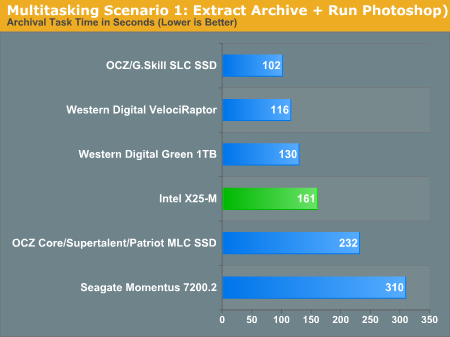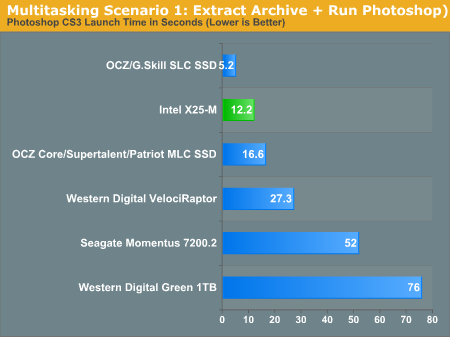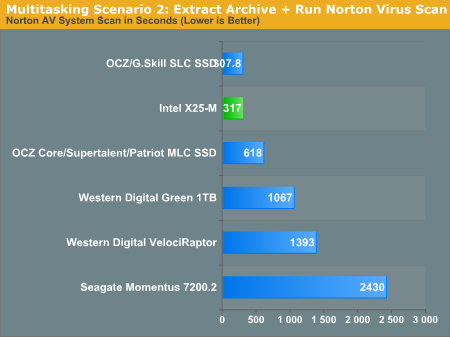Intel X25-M SSD: Intel Delivers One of the World's Fastest Drives
by Anand Lal Shimpi on September 8, 2008 4:00 PM EST- Posted in
- Storage
The Killer App: Multitasking Performance
Here's where things get interesting. I ran two tests, in one I extracted a 5GB archive and tried to run Photoshop after 30 seconds of extraction and in the second test, I extracted a 5GB archive and tried to scan my system for viruses using NAV 2008. Simple enough, right? I'm reporting the times of each task individually.
The extraction task took the longest to complete but the standings speak for themselves:

Here's one area where the Samsung SLC based devices actually come out ahead, by a good margin. The Samsung SLC SSD finished the extraction in 102 seconds, compared to 161 seconds for the X25-M. Even the VelociRaptor did better here at 116 seconds, but remember you need to look at both tasks for a complete picture:

Launching Photoshop took 5.2 seconds for the Samsung SLC SSD, it was like we weren't even running another test in the background. The X25-M did fine at 12.2 seconds and the VelociRaptor was much slower at 27.3 seconds. The JMicron based MLC drives didn't do too bad here either, although they were a little slower than Intel's MLC offering.
The real stress test was this next multitasking scenario. Quite possibly one of the most annoying thing about viruses is having to run real time scanning and protection software all the time, especially with a traditional HDD in your system. The extraction task is the same as before, but the other task is a full system scan in Norton Anti-Virus 2008. I timed both:

The WD 1TB drive would always complete the extraction task quicker than all of the other drives, but paid the penalty in the scan test (which is why you have to look at both charts for a full analysis). The Samsung SLC drive is still the overall winner here, followed closely by Intel's X25-M. The JMicron based MLC drives do horribly here, taking over twice as long to complete as Intel's MLC.
The mechanical disks however do a lot worse. While the Intel X25-M took 3.5 minutes to extract the 5GB archive, the VelociRaptor took over 17 minutes. The Seagate Momentus 7200.2 took over 23 minutes!
Let's look at the NAV results:

The X25-M took around 5.3 minutes, the Raptor needed more than 23 minutes and Seagate Momentus made me wait over 40 minutes. It's these sorts of usage scenarios that really make SSDs worthwhile, and they are the most realworld you can get. When we started looking at real world performance the PCMark Vantage numbers may have looked a bit ridiculous, but by now you should see that they are more of the middle ground when looking at performance of these drives.










96 Comments
View All Comments
Mocib - Thursday, October 9, 2008 - link
Good stuff, but why isn't anyone talking about ioXtreme, the PCI-E SSD drive from Fusion-IO? It baffles me just how little talk there is about ioXtreme, and the ioDrive solution in general.Shadowmaster625 - Thursday, October 9, 2008 - link
I think the Fusion-IO is great as a concept. But what we really need is for Intel and/or AMD to start thinking intelligently about SSDs.AMD and Intel need to agree on a standard for an integrated SSD controller. And then create a new open standard for a Flash SSD DIMM socket.
Then I could buy a 32 or 64 GB SSD DIMM and plug it into a socket next to my RAM, and have a SUPER-FAST hard drive. Imagine a SSD DIMM that costs $50 and puts out even better numbers than the Fusion-IO! With economy of scale, it would only cost a few dollers per CPU and a few dollars more for the motherboard. But the performance would shatter the current paradigm.
The cost of the DIMMs would be low because there would be no expensive controller on the module, like there is now with flash SSDs. And that is how it should be! There is NO need for a controller on a memory module! How we ended up taking this convoluted route baffles me. It is a fatally flawed design that is always going to be bottlenecked by the SATA interface, no matter how fast it is. The SSD MUST have a direct link to the CPU in order to unleash its true performance potential.
This would increase performance so much that if VIA did this with their Nano CPU, they would have an end product that outperforms even Nehalem in real-world everyday PC usage. If you dont believe me, you need to check out the Fusion-IO. With SSD controller integration, you can have Fusion-IO level performance for dirt cheap.
If you understand what I am talking about here, and can see that this is truly the way to go with SSDs, then you need to help get the word to AMD and Intel. Whoever does it first is going to make a killing. I'd prefer it to be AMD at this point but it just needs to get done.
ProDigit - Tuesday, October 7, 2008 - link
Concerning the Vista boottime,I think it'd make more sense to express that in seconds rather than MB/s.I rather have a Windows boot in 38seconds article,than a windows boots with 51MB/s speeds.. That'd be totally useless to me.
Also, I had hoped for entry level SSD cards, replacements for mininotebooks rather in the category of sub 150$ drives.
On an XP machine, 32GB is more then enough for a mininotebook (8GB has been done before). Mininotebooks cost about $500,and cheap ones below $300. I,as many out there, am not willing to spend $500 on a SSD drive, when the machine costs the same or less.
I had hoped maybe a slightly lower performance 40GB SSD drive could be sold for 149$,which is the max price for SSD cards for mini notebooks.
for laptops and normal notebooks drives upto 200-250$ range would be enough for 64-80GB. I don't agree on the '300-400' region being good for SSD drives. Prices are still waaay too high!
Ofcourse we're paying a lot of R&D right now,prices should drop 1 year from now. Notebooks with XP should do with drives starting from 64GB,mini notebooks with drives from 32-40GB,and for desktops 160GB is more than enough. In fact, desktops usually have multiple harddrives, and an SSD is only good for netbooks for it's faster speeds, and lower powerconsumption.
If you want to benefit from speeds on a desktop,a 60-80GB will more then do, since only the Windows, office applications, anti-virus and personal programs like coreldraw, photoshop, or games need to be on the SSD drive.
Downloaded things, movies, mp3 files, all those things that take up space might as well be saved on an external/internal second HD.
Besides if you can handle the slightly higher game loadtimes on conventional HD's, many older games already run fine (over 30fps) on full detail, 1900x??? resolution.
Installing older games on an SSD doesn't really benefit anyone, apart from the slightly lower loadtimes.
Seeing that I'd say for the server market highest speed and largest diskspace-size matter, and occasionally also lowest power consumption matter.
=> highest priced SSD's. X >$1000, X >164GB /SSD
For the desktop high to highest speed matters, less focus on diskspace size and power consumption.
=> normal priced SSD's $250 > X > $599 X > 80GB/SSD
For the notebooks high speed and lowest power consumption matter, smaller size as compensation for price.
=> Normal priced SSD's $175 > X > $399 X > 60GB/SSD
For the mininotebook normal speed, and more focus on lower power consumption and lowest pricing matter!
=> Low powered small SSD's $75 > X > $199 X > 32GB/SSD
gemsurf - Sunday, October 5, 2008 - link
Just in case anyone hasn't noticed, these are showing up for sale all over the net in the $625 to $750 range. Using live search, I bought one from teckwave on ebay yesterday for $481.80 after the live search cashback from microsoft.BTW, Does Jmicron do anything right? Seems I had AHCI/Raid issues on the 965 series Intel chipsets a few years back with jmicron controllers too!
Shadowmaster625 - Wednesday, September 24, 2008 - link
Obviously Intel has greater resources than you guys. No doubt they threw a large number of bodies into write optimizations.But it isnt too hard to figure out what they did. I'm assuming that when the controller is free from reads or writes, that is when it takes the time to actually go and erase a block. The controller probably adds up all the pages that are flagged for erasure, and when it has enough to fill an entire block, then it goes and erases and writes that block.
Assuming 4KB pages and 512KB blocks (~150,000 blocks per 80GB device) what Intel must be doing is just writing each page wherever they could shove it. And erasing one block while writing to all those other blocks. (With that many blocks you could do a lot of writing without ever having to wait for one to erase.) And I would go ahead and have the controller acknowledge the data was written once it is all in the buffer. That would free up the drive as far as Windows is concerned.
If I was designing one of these devices, I would definately demand as much SRAM as possible. I dont buy that line of bull about Intel not using the SRAM for temporary data storage. That makes no sense. You can take steps to ensure the data is protected, but making use of SRAM is key to greater performance in the future. That is what allows you to put off erasing and writing blocks until the drive is idle. Even a SRAM storage time limit of just one second would add a lot of performance, and the risk of data loss would be negligable.
Shadowmaster625 - Wednesday, September 24, 2008 - link
OCZ OCZSSD2-1S32G32GB SLC, currently $395
The 64GB version is more expensive than the Intel right now, but with the money they've already raked in who really thinks they wont be able to match intel performance or pricewise? Of course they will. So how can this possibly be that great of a thing? So its a few extra GB. Gimme a break, I would rather take the 32GB and simply juggle around stuff onto my media drive every now and then. Did you know you can simply copy your entire folder from the Program Files directory over to your other drive and then put it back when you want to use it? I do that with games all the time. It takes all of 2 minutes... Why pay hundreds of dollars extra to avoid having to do that? It's just a background task anyway. That's how 32GB has been enough space for my system drive for a long time now. (Well, that and not using Vista.) At any rate this is hardly a game changer. The other MLC vendors will address the latency issue.
cfp - Tuesday, September 16, 2008 - link
Have you seen any UK/Euro shops with these available (for preorder even?) yet? There are many results on the US Froogle (though none of them seem to have stock or availability dates) but still none on the UK one.Per Hansson - Friday, September 12, 2008 - link
What about the Mtron SSD'sYou said they used a different controller vs Samsung in the beginning of the article but you never benchmarked them?
7Enigma - Friday, September 19, 2008 - link
I would like to know the question to this as well...NeoZGeo - Thursday, September 11, 2008 - link
The whole review is based on Intel vs OCZ Core. We all know OCZ core had issues that you have mentioned. However, what I would like to see is other drives test bench against OCZ core drive, or even the core II drive. Suppose the controller has a different firmware according to some guys from OCZ on the core 2, and I find that a bit bias if you are using a different spec item to represent all the other drives in the market.